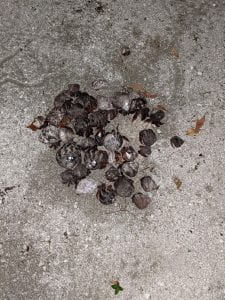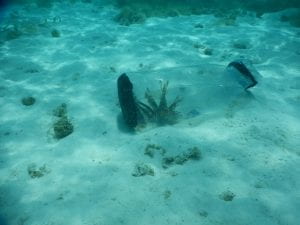Another early and eventful morning. After breakfast we went out on the boat to the fore reef, just outside the coral circle of the atoll. Once we got outside the reef the waters got choppy and I got seasick a little bit, I thought once I got in the water I would feel better but I still felt sick whenever I looked up out of the water. I was perfectly happy to just lie in the water and stare down below and get pushed around by the waves. Wherever we were was at least 60 feet deep I think, but it felt way deeper. One of our water safety officers free dove all the way almost to the bottom! I had no idea that was even possible for someone to do, but we looked down and he was just swimming along the bottom below us. We saw lots of fish, but a little too deep to get a good look, and even a sea turtle way below us. We swam over to the drop off, like in finding nemo, you suddenly can’t see the bottom of the water anymore and it just drops into deep blue and then black, maybe it only goes a little bit deeper, maybe it goes miles deep, you just can’t tell or see anything past the darkness. Weirdly instead of being scared I was just more curious then anything. My first lab research experience was with hydrothermal vents and those extremophilic organisms around them, so most of my first marine knowledge was of the deep sea instead of coral reefs. I would love to someday get SCUBA certified and dive right down to the bottom to just see what’s there past what I can see from the top. And someday I’m going to go in a submarine to the bottom of the ocean if I can, I want to see everything down there, it’ll be like stepping into a completely new world.
I got pretty seasick on the way back, luckily I kept my breakfast because it’s a shame to lose a good meal, and took a short nap on the dock to get my bearings. After lunch we put together a beach cleanup activity! We managed to collect about 64 kg of trash across the island and sort it out for disposal. Highlights include:
a complete fish skeleton (not trash, just cool).
A full tube of mascara
A tiny plastic sheep
A bottle of bright blue dye that turned everything else blue
A bottle of yellow smelly liquid (pee? I really hope not)
Several baby flip-flops (why do they need shoes, they can’t even walk)
A single Balenciaga slide
and lots and lots of plastic bottles.
There was plenty more trash but our bags were overflowing and we can only carry so much. It’s really sad how much there is on what’s supposed to be a conservation site, just washing up from other islands and everywhere else in the world the currents take it.
Before dinner Nate handed out some of the shells he collected to the local hermit crabs. One of them actually accepted it, and began to examine it closely, preparing for a move. We stood in a circle around it, completely frozen so we wouldn’t scare it and watched and cheered when it moved shells into a nice new shell that was a better shape and size.
The crab was treated to some coconut, because moving is stressful.
And the coconut was quickly swarmed by the other crabs, hopefully our friend got plenty to eat before it got crowded!






